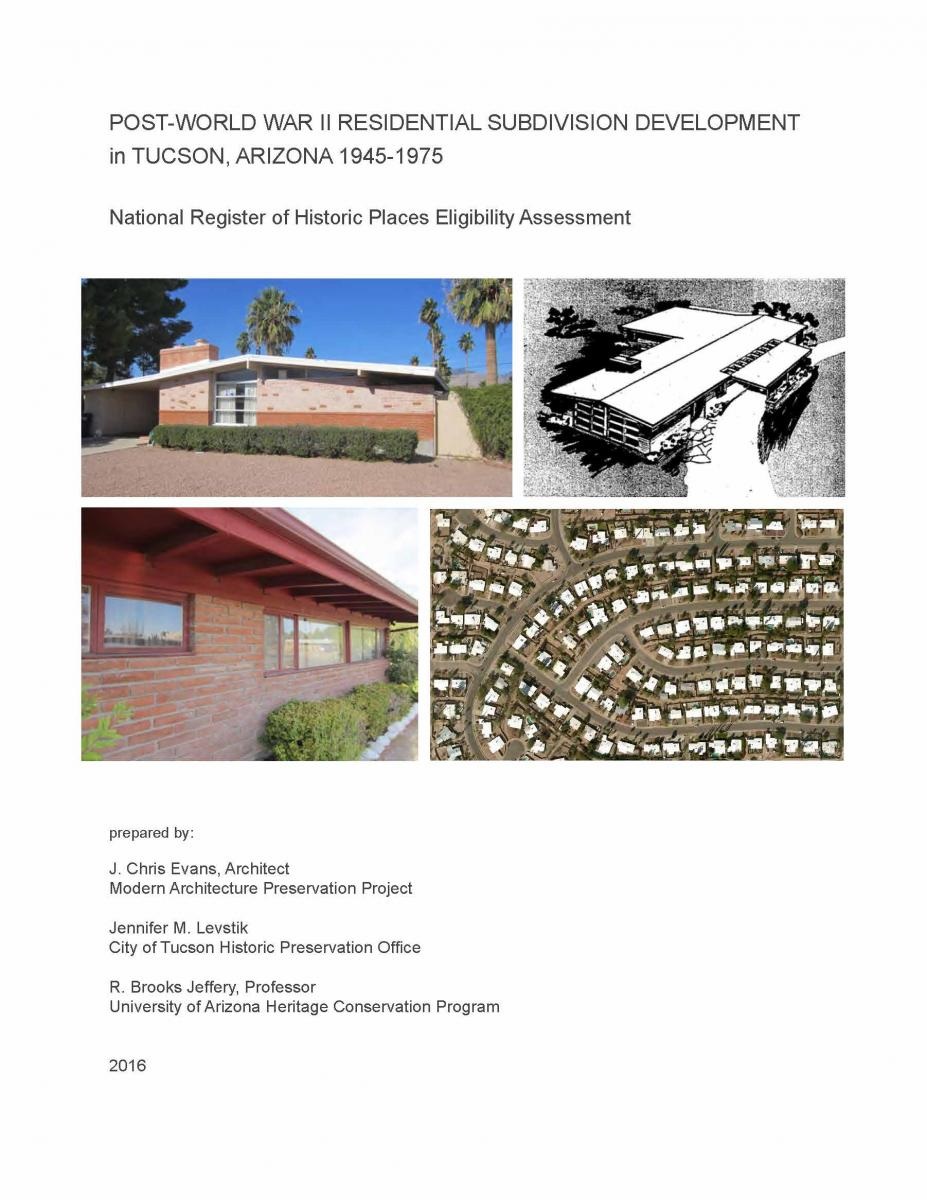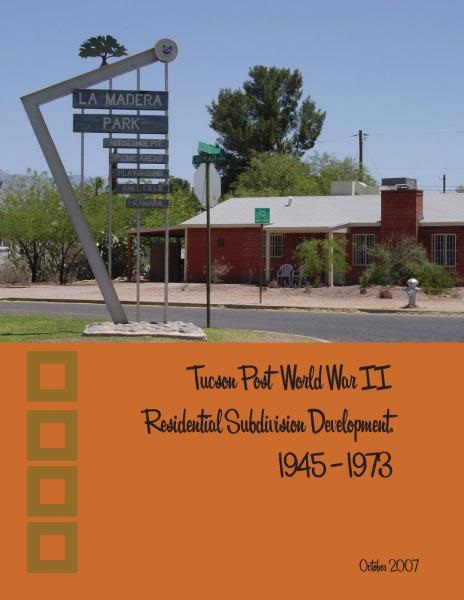Reports and Surveys
 Post-World War II Residential Subdivision Development in Tucson, Arizona 1945-1975
Post-World War II Residential Subdivision Development in Tucson, Arizona 1945-1975
Report(PDF, 8MB)
Maps(PDF, 17MB)

A Guide to Tucson's Historic Neighborhoods(PDF, 605KB) provides an overview of Tucson's development over time as represented by the architecture in our local historic neighborhoods. Descriptions and depictions of 23 exemplary architectural styles and brief histories of 29 historic neighborhoods are included. The map allows users to tour the areas on their own.
Copies are available at all Tucson branch libraries, the Loop Store at the Southern Arizona Heritage and Visitor Center Gift Shop, and select merchants or email benapresident@gmail.com.

Architecture of the Modern Movement in Tucson, 1945-1975 (DRAFT)(PDF, 1MB)
This document is a context study of modern architecture in Tucson, Arizona built between 1945 and 1975. The document encompasses commercial, institutional, and residential buildings that were designed as part of the Modern Movement.

Tucson Post-WWII Residential Subdivision Development, 1945-1973(PDF, 4MB)
Tucson's population boom after World War II was accompanied by new architectural styles and construction techniques which now represent a significant portion of our community's historic fabric. This report, completed in 2007, summarizes these trends and includes typologies of Tucson's post-War residential architecture and landscaping.
Report(PDF, 4MB)
Maps(PDF, 2MB)

Tucson Health Seekers Architecture(PDF, 22MB)
Listed January 2013
As early as the 1880s, Arizona was a popular destination for Easterners suffering from pulmonary and respiratory diseases. After World War I and continuing into the late 1920s, however, Tucson became the prime destination for those suffering from respiratory ailments such as tuberculosis. It was during this time that doctors commonly prescribed Tucson’s dry climate and plentiful sunshine as curative. In Tucson, tuberculosis not only impacted town planning, but it also influenced local architecture and the kinds of sanatoria created to meet the needs of the sick. Tucson's historical sanatoria architecture and tuberculosis-related properties include tent cities, homesteads, hospitals, convalescent homes, and boarding houses. Tucson Health Seekers Multiple Properties Documentation Form(PDF, 22MB) and Tucson Health Seekers Architectural Drawings(PDF, 25MB).

Historic Miracle Mile: Tucson's Northern Auto Gateway(PDF, 3MB)
This historic context study was developed in 2009 as a resource for the Oracle Area Revitalization Project. Over 160 non-residential properties within the project area were evaluated, and a period of significance—1920 to 1973—was identified for this historic corridor.

The Neon Pueblo
The Tucson Historic Preservation Foundation, with support from the Arizona Humanities Council, produced this award-winning driving guide to Tucson's midcentury vintage advertising.

El Tiradito Shrine (Historic American Landscape Survey(PDF, 1MB)
El Tiradito Shrine was listed in the National Register of Historic Places in 1971 and is significant for its role in the development of Hispanic folklore and folk customs that developed in what is now the American Southwest. This Historic American Landscapes Survey won an award from the National Park Service in 2012.

Arizona Inn (Historic American Landscape Survey)(PDF, 1MB)
The Arizona Inn was listed in the National Register of Historic Places in 1988 and is significant for its association with Isabella Greenway, Arizona's first female congresswoman, and its embodiment of Pueblo and Spanish Colonial revival architecture as designed by noted local architect Merritt Starkweather. This Historic American Landscape Survey won a national award from the National Parks Service in 2013.

Tucson Plant Materials Center (Historic American Landscape Survey)(PDF, 4MB)
Listed in the National Register of Historic Places in 1996, the Tucson Plant Materials Center was established in direct response to Depression-era New Deal legislation aimed at identifying plant species to combat environmental drought and soil erosion. As one of the first of 14 plant materials centers constructed in the United States, it remains one of four still in operation today and as the headquarters of the Southwest region.

Benefits of Historic Designation for Property Owners(PDF, 39KB)

Guide for Green Retrofitting Historic Homes(PDF, 677KB)
This guide provides illustrations and instructions on how to make your historic home more sustainable while at the same time respecting its character-defining historic features.